Scapulothoracic Bursitis
The scapulothoracic joint is located where the shoulder blade or scapula joins the rib cage. The scapula moves easily due to the presence of bursa (fluid filled sacs) which helps in the smooth movement of the joint. Inflammation of the bursa is termed scapulothoracic bursitis. This inflammation may be caused due to over usage, consistent motion and repetitive movements of the joint.
The various symptoms of scapulothoracic bursitis include:
- Grinding, grating and snapping noises during movement of the shoulders
- Pain during movement of the shoulders
- Pain in the scapula (shoulder blade) or ribcage.
Scapulothoracic bursitis is diagnosed based on your child’s medical history and conducting a physical examination to check for the symptoms. Your doctor may also perform imaging tests like X-rays or MRI scans to get a clear picture of the inner aspects of the shoulder blade and confirm diagnosis.
Based on the severity of the condition, scapulothoracic bursitis can be treated both surgically and non-surgically.
- Non-surgical treatment: these treatments include anti-inflammatory medications, strengthening the muscles around the shoulder blade and giving corticosteroid injections to reduce inflammation of the bursa.
- Surgical treatment: this treatment is used when the non-surgical treatment fails to provide relief. Surgical procedures are mostly performed arthroscopically and involve removal of the inflamed bursa along with any bony extensions on the shoulder which are rubbing against the ribcage.
-
Personalized Physical Therapy Puts Bryant Back on the Court
Bryant could hear the whistles blowing as he walked by the gymnasium.
View more -
No off-season for sports injuries
As a new season of school sports and youth leagues gets underway,
View more -
Student Athletes Benefit from Individualized Treatment at U18 Sports Medicine
Becoming involved in a sport is one of the healthiest things that a child can do.
View more -
For young athletes, injuries need special care
More programs are using procedures and surgical techniques tailored for kids.
View more -
Dr Frank u18 Tip 1
 View more
View more -
Segment U18 Tip with Dr Frank 1
 View more
View more -
Dr. Frank’s 2010 WQAM high school football game halftime interviews
View more




 Menu
Menu






 In The News
In The News Hollywood Office
Hollywood Office

![[U18] Sports Medicine](https://www.kidbones.net/wp-content/themes/ypo-theme/images/u18-sports-medicine-performing-arts-logo.png)












